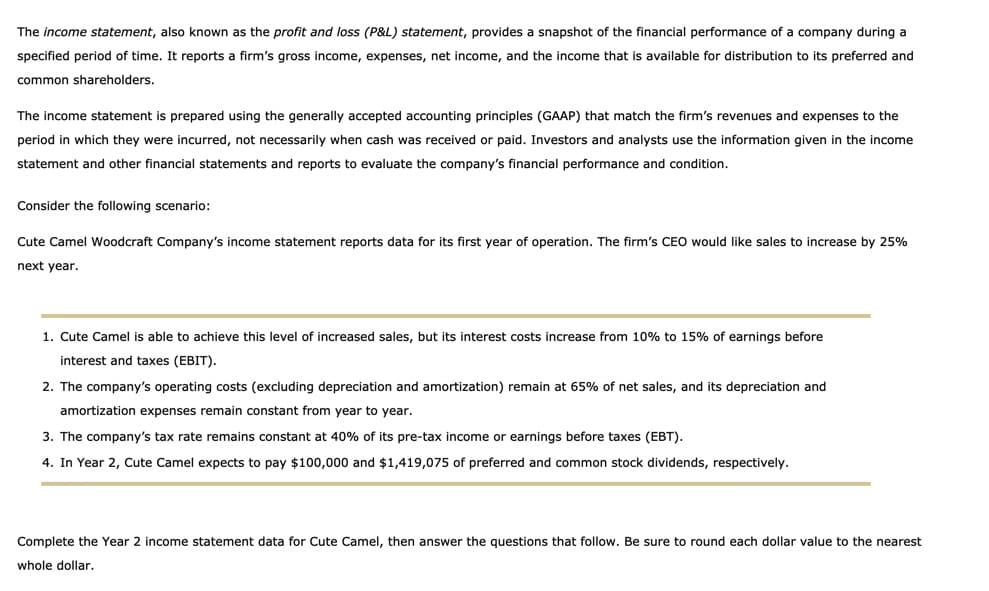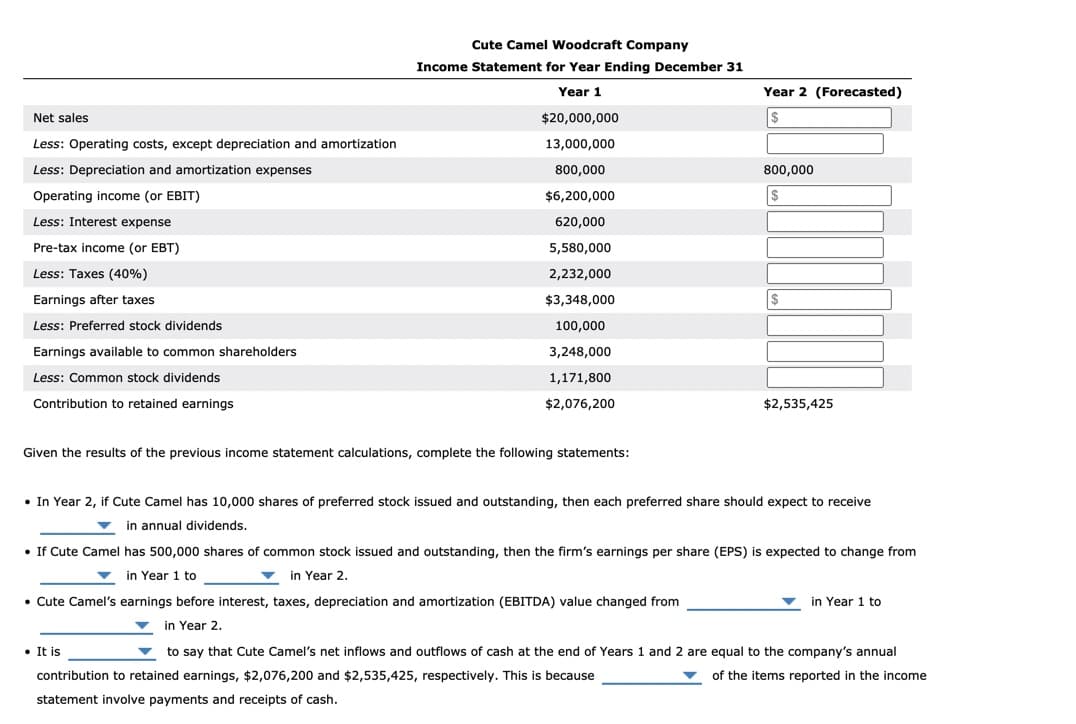The income statement, also known as the profit and loss (P&L) statement, provides a snapshot of the financial performance of a company during a specified period of time. It reports a firm's gross income, expenses, net income, and the income that is available for distribution to its preferred and common shareholders. The income statement is prepared using the generally accepted accounting principles (GAAP) that match the firm's revenues and expenses to the period in which they were incurred, not necessarily when cash was received or paid. Investors and analysts use the information given in the income statement and other financial statements and reports to evaluate the company's financial performance and condition. Consider the following scenario: Cute Camel Woodcraft Company's income statement reports data for its first year of operation. The firm's CEO would like sales to increase by 25% next year. 1. Cute Camel is able to achieve this level of increased sales, but its interest costs increase from 10% to 15% of earnings before interest and taxes (EBIT). 2. The company's operating costs (excluding depreciation and amortization) remain at 65% of net sales, and its depreciation and amortization expenses remain constant from year to year. 3. The company's tax rate remains constant at 40% of its pre-tax income or earnings before taxes (EBT).
The income statement, also known as the profit and loss (P&L) statement, provides a snapshot of the financial performance of a company during a specified period of time. It reports a firm's gross income, expenses, net income, and the income that is available for distribution to its preferred and common shareholders. The income statement is prepared using the generally accepted accounting principles (GAAP) that match the firm's revenues and expenses to the period in which they were incurred, not necessarily when cash was received or paid. Investors and analysts use the information given in the income statement and other financial statements and reports to evaluate the company's financial performance and condition. Consider the following scenario: Cute Camel Woodcraft Company's income statement reports data for its first year of operation. The firm's CEO would like sales to increase by 25% next year. 1. Cute Camel is able to achieve this level of increased sales, but its interest costs increase from 10% to 15% of earnings before interest and taxes (EBIT). 2. The company's operating costs (excluding depreciation and amortization) remain at 65% of net sales, and its depreciation and amortization expenses remain constant from year to year. 3. The company's tax rate remains constant at 40% of its pre-tax income or earnings before taxes (EBT).
Cornerstones of Financial Accounting
4th Edition
ISBN:9781337690881
Author:Jay Rich, Jeff Jones
Publisher:Jay Rich, Jeff Jones
Chapter3: Accrual Accounting
Section: Chapter Questions
Problem 1MCQ: Which of the following statements is true? Under cash-basis accounting, revenues are recorded when a...
Related questions
Question
100%
Please just complete income statement, and the following blanks.

Transcribed Image Text:The income statement, also known as the profit and loss (P&L) statement, provides a snapshot of the financial performance of a company during a
specified period of time. It reports a firm's gross income, expenses, net income, and the income that is available for distribution to its preferred and
common shareholders.
The income statement is prepared using the generally accepted accounting principles (GAAP) that match the firm's revenues and expenses to the
period in which they were incurred, not necessarily when cash was received or paid. Investors and analysts use the information given in the income
statement and other financial statements and reports to evaluate the company's financial performance and condition.
Consider the following scenario:
Cute Camel Woodcraft Company's income statement reports data for its first year of operation. The firm's CEO would like sales to increase by 25%
next year.
1. Cute Camel is able to achieve this level of increased sales, but its interest costs increase from 10% to 15% of earnings before
interest and taxes (EBIT).
2. The company's operating costs (excluding depreciation and amortization) remain at 65% of net sales, and its depreciation and
amortization expenses remain constant from year to year.
3. The company's tax rate remains constant at 40% of its pre-tax income or earnings before taxes (EBT).
4. In Year 2, Cute Camel expects to pay $100,000 and $1,419,075
preferred and common stock dividends, respectively.
Complete the Year 2 income statement data for Cute Camel, then answer the questions that follow. Be sure to round each dollar value to the nearest
whole dollar.

Transcribed Image Text:Cute Camel Woodcraft Company
Income Statement for Year Ending December 31
Year 1
Year 2 (Forecasted)
Net sales
$20,000,000
Less: Operating costs, except depreciation and amortization
13,000,000
Less: Depreciation and amortization expenses
800,000
800,000
Operating income (or EBIT)
$6,200,000
Less: Interest expense
620,000
Pre-tax income (or EBT)
5,580,000
Less: Taxes (40%)
2,232,000
Earnings after taxes
$3,348,000
$
Less: Preferred stock dividends
100,000
Earnings available to common shareholders
3,248,000
Less: Common stock dividends
1,171,800
Contribution to retained earnings
$2,076,200
$2,535,425
Given the results of the previous income statement calculations, complete the following statements:
• In Year 2, if Cute Camel has 10,000 shares of preferred stock issued and outstanding, then each preferred share should expect to receive
in annual dividends.
• If Cute Camel has 500,000 shares of common stock issued and outstanding, then the firm's earnings per share (EPS) is expected to change from
in Year 1 to
in Year 2.
• Cute Camel's earnings before interest, taxes, depreciation and amortization (EBITDA) value changed from
in Year 1
in Year 2.
• It is
to say that Cute Camel's net inflows and outflows of cash at the end of Years 1 and 2 are equal to the company's annual
contribution to retained earnings, $2,076,200 and $2,535,425, respectively. This is because
of the items reported in the income
statement involve payments and receipts of cash.
Expert Solution
This question has been solved!
Explore an expertly crafted, step-by-step solution for a thorough understanding of key concepts.
This is a popular solution!
Trending now
This is a popular solution!
Step by step
Solved in 2 steps with 2 images

Recommended textbooks for you

Cornerstones of Financial Accounting
Accounting
ISBN:
9781337690881
Author:
Jay Rich, Jeff Jones
Publisher:
Cengage Learning

Financial Accounting
Accounting
ISBN:
9781337272124
Author:
Carl Warren, James M. Reeve, Jonathan Duchac
Publisher:
Cengage Learning

Intermediate Accounting: Reporting And Analysis
Accounting
ISBN:
9781337788281
Author:
James M. Wahlen, Jefferson P. Jones, Donald Pagach
Publisher:
Cengage Learning

Cornerstones of Financial Accounting
Accounting
ISBN:
9781337690881
Author:
Jay Rich, Jeff Jones
Publisher:
Cengage Learning

Financial Accounting
Accounting
ISBN:
9781337272124
Author:
Carl Warren, James M. Reeve, Jonathan Duchac
Publisher:
Cengage Learning

Intermediate Accounting: Reporting And Analysis
Accounting
ISBN:
9781337788281
Author:
James M. Wahlen, Jefferson P. Jones, Donald Pagach
Publisher:
Cengage Learning


Financial Reporting, Financial Statement Analysis…
Finance
ISBN:
9781285190907
Author:
James M. Wahlen, Stephen P. Baginski, Mark Bradshaw
Publisher:
Cengage Learning

Principles of Accounting Volume 1
Accounting
ISBN:
9781947172685
Author:
OpenStax
Publisher:
OpenStax College